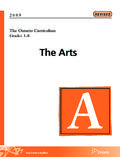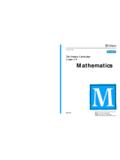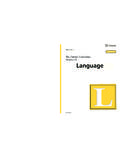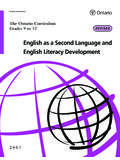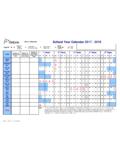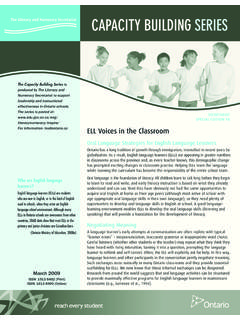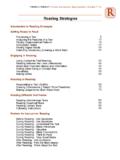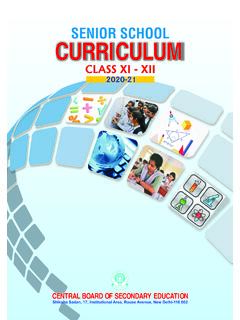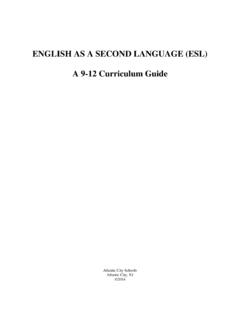Transcription of The Ontario Curriculum Grades1-8
1 The Ontario CurriculumGrades 1-8 Ministry of Education2001 Native LanguagesContentsIntroduction ..3 Achievement Levels .. 12 Strands in the Native language Curriculum .. 14 Curriculum Expectations for Grades 1 to 8 .. 17 Explanatory Notes .. 37 Une publication quivalente est disponible en fran ais sous letitre suivant : Le Curriculum de l Ontario , de la 1re la 8eann e Langues autochtones, publication is available on the Ministry of Educationwebsite at Native language program for Grades 1 to 8 has been designed to provide a dynamic andchallenging Curriculum . It has been developed to provide: (a) a general understanding of thenature and function of language , which will serve as the basis for the development of Nativelanguage skills; (b) a foundation of language knowledge and skills in the Native languageunder study that will enable students to communicate in the Native language .
2 And (c) anunderstanding and appreciation of the Native language as an expression of a distinctive ultimate goal of the Native language program is to inspire Native students with pride intheir ancestral language and to motivate them to use it to communicate in their daily lives touse it, in other words, as a living language that is part of a living Place of Native Languages in the CurriculumLanguage carries within it the spirit, culture, history, and philosophy of a people; it revealshow they think and how they view the world . In short, language both defines and reflects theparticular attitudes and values of a people. language , moreover, is the principal means bywhich culture is preserved and transmitted from one generation to another.
3 First Nationcommunities are concerned that their languages and cultures are being lost; in some areas ofthe province, many of the younger generation can no longer speak or understand their ances-tral language . The establishment of Native language programs in Ontario schools is thereforean important step towards reclaiming and revitalizing Native no study has as yet been undertaken to assess the long-term effects of Native students exposure to their languages and cultures, a link has been established between students self-image and their success as learners. Since the study of their own language and culture willstrengthen Native students sense of self, both as individuals and as members of a culture withdistinctive and relevant traditions, there is every reason to expect that Native students enrolledin Native language courses will be better motivated to learn and to put the kind of effort intotheir school work that leads to Native language program in elementary schools in Ontario is not intended exclusively forNative students from First Nation communities.
4 The program is open to all Native and non-Native students who want to learn a Native language and develop a better understanding ofthe culture of which that language forms part. Non-Native students enrolled in Native lan-guage programs will enjoy the benefits of cross-cultural education. By learning about a culturethat is different from their own, they will both expand and enrich their view of the world andgain a better understanding of their own culture. At the same time, they will develop a deeperappreciation of and respect for the identity, rights, and values of Ontario Curriculum , GRADES 1 8: NATIVE LANGUAGES, 20015 The Purpose of The Ontario Curriculum , Grades 1 8: Native Languages, 2001 This document sets out the minimum expectations that students enrolled in Native languageprograms are required to achieve in each grade from Grade 1 to Grade 8.
5 It also provides a listof language elements for each grade. The language elements introduced in one grade arebroadened or reinforced in subsequent years, thus permitting a steady growth of knowledgeand skills from grade to document supersedes Native Languages, Part A: Policy and Program Considerations; Primary,Junior, Intermediate, and Senior Divisions, 1987. All Native language programs in Grades 1 to 8will be based on the Curriculum expectations outlined in this Relating to Native language ProgramsAccording to current policy pertaining to elementary school Core French (FSL), all studentsentering Grade 4 must receive French instruction in every year from Grade 4 to Grade , policy pertaining to the relationship between FSL and Native language programsstates that students are to be exempted from the FSL program if their parents1decide, afterconsultation with the principal, that it is in their best interests not to receive French instruc-tion.
6 In elementary schools where the parents or guardians want their children to participatein both a Native language program and an FSL program, principals will have to make arrange-ments to accommodate both language Native language program comprises expectations that students are to achieve in eachgrade from Grade 1 to Grade 8. However, school boards may choose to design their programsin such a way that students can enter them in Grade 4 rather than Grade 1. Boards that chooseto start their programs at Grade 4 must ensure that students are given the opportunity toachieve all of the expectations outlined in this document by Grade Native language programs are to be offered during the school day. A minimum of 20 min-utes should be allocated to the program per day in Grades 1, 2, and 3, and 40 minutes shouldbe allocated per day in Grades 4 to a school board decides to offer a Native language program at the elementary level, itshould take into account that the program must be offered through to the end of Native language program may be offered in any of the following languages: Cayuga,Cree, Delaware, Mohawk, Ojibwe, Oji-Cree, and Aims of the Native language ProgramThe principal aims of the Native language program the development of language skills andthe development of cultural awareness are inseparable.
7 Cultures vary in the way they viewdifferent aspects of life as well as in the ways in which they express ideas and feelings aboutthese aspects of life. Learning a language , therefore, involves discovering a culture s distinctiveforms of expression. The Native language program develops an understanding of the nature oflanguage, basic communication skills in Native languages, and an appreciation of Native cul-tures in Canada and the rest of North The word parents, as used in this document, includes both parent(s) and guardian(s).INTRODUCTION6 The Native language program is not designed to make students fully bilingual; rather, the pro-gram offers students the opportunity to develop a basic command of a Native language that canbe expanded through further study or through contact with other speakers of the program allows students to develop their language skills and improve their use of lan-guage through study, practice, and communication.
8 Students are given learning opportunitiesthat will allow them to develop their language skills in all three areas of language use oralcommunication, reading, and writing. Students will thus have opportunities to listen to variousforms of oral communication and to understand ideas and concepts expressed in the Nativelanguage under study; to talk about their experiences and to express their thoughts and feelingswith clarity and confidence; to read written materials in the Native language , including its literature, with growing proficiency; and to write in the Native language using a Native language writing addition, students will become familiar with the traditions, cus-toms, social structures, history, and arts of the pertinent Native culture.
9 Activities that willallow students to link their classroom experiences with life in their community and in othercommunities through electronic technology will also be elementary Curriculum for Native language programs is designed to prepare students forsuccess in Native language programs at the secondary expectations that form thebasis of the secondary school Curriculum build on the knowledge and skills that studentsacquire in their elementary Expectations and Achievement LevelsThe Ontario Curriculum for Native language programs comprises two elements: curriculumexpectations and achievement levels. The expectations identified for each grade describe theknowledge and skills that students are expected to develop and to demonstrate in their classwork, on tests, and in various other activities on which their achievement is assessed.
10 Theachievement levels are to be used in assessing students achievement of the sets of expectations are listed for each grade. The overall expectationsdescribe in generalterms the knowledge and skills that students are expected to achieve in all strands, or broad Curriculum areas, by the end of each grade. The specific expectationsdescribe the expectedknowledge and skills in greater detail. Since the overall expectations describe knowledge andskills that are fundamental to the Native language program as a whole, they sometimes remainthe same from grade to grade or are only slightly modified to indicate a higher level of sequential progression from grade to grade is more evident in the specific expectations,which describe the knowledge and skills expected at particular stages in more specific specific expectations are organized into three strands, which correspond to the three mainareas of language use: oral communication, which includes listening and speaking; reading;and writing.
